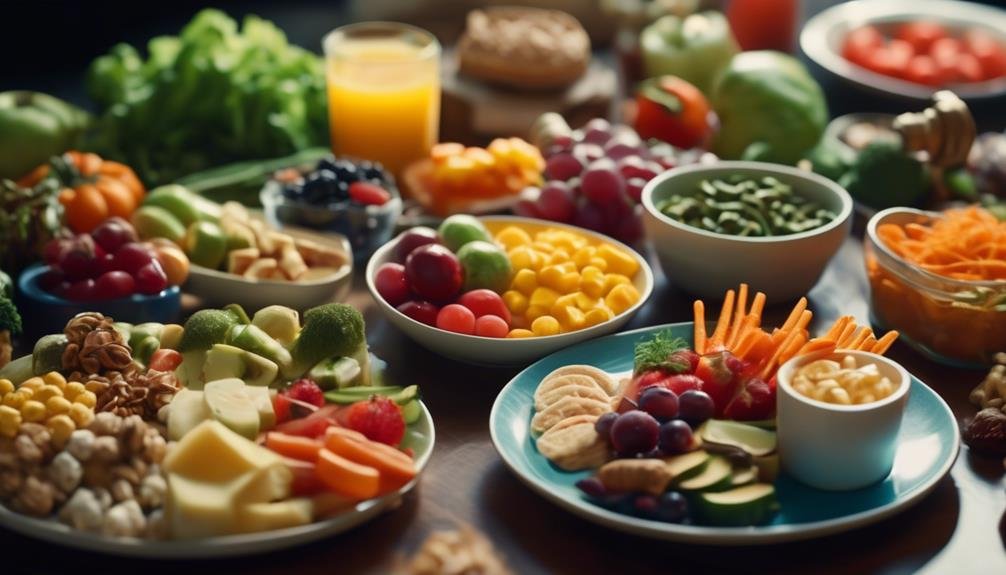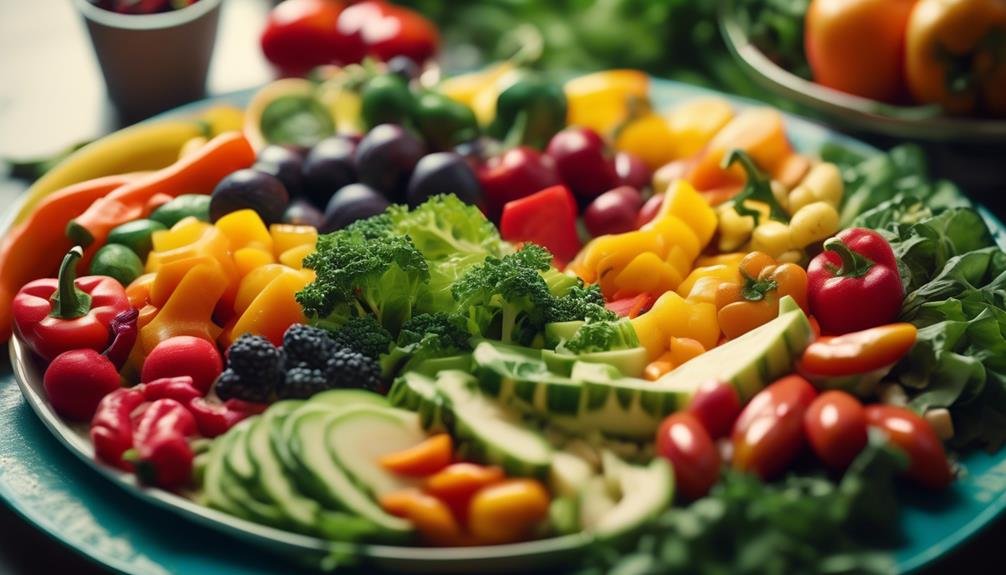"Cherishing Little Steps - A Haven for Baby and Family Journeys"
Balanced Meal Planning
They say, 'You are what you eat.' And when it comes to balanced meal planning, nothing could be truer.
Are you tired of feeling sluggish, lacking energy, or struggling with your weight? It's time to take control of your health and well-being by nourishing your body with the right foods.
But where do you start? In this discussion, we will explore the importance of balanced meal planning, discover the key components of a balanced meal, and provide you with practical tips and healthy swaps to make meal prepping a breeze.
Get ready to embark on a journey towards a healthier, happier you.
Key Takeaways
- Balanced meal planning ensures meals are nutritionally balanced and tailored to individual needs.
- Meal prepping helps to stay organized and avoid unhealthy choices.
- Healthy swaps and substitutions can be made to make meals more nutritious.
- Incorporating variety in meals by trying different fruits, vegetables, and cuisines adds depth and complexity to meals.
Importance of Balanced Meal Planning

Balanced meal planning plays a crucial role in maintaining a healthy diet by ensuring that your meals are nutritionally balanced and tailored to your individual needs. When it comes to weight loss, meal planning has numerous benefits that can help you achieve your goals effectively.
One of the key benefits of meal planning for weight loss is portion control. By planning your meals in advance, you can carefully measure and control the amount of food you consume. This can prevent overeating and help you maintain a caloric deficit, which is essential for weight loss.
Additionally, meal planning allows you to make healthier food choices. When you plan your meals ahead of time, you have the opportunity to include a variety of nutrient-dense foods such as fruits, vegetables, lean proteins, and whole grains. These foods are rich in vitamins, minerals, and fiber, which can support weight loss and improve overall health.
Moreover, meal planning eliminates the need for impulsive and unhealthy food choices. By having a well-thought-out meal plan, you can avoid relying on fast food or processed meals, which tend to be high in calories, unhealthy fats, and added sugars. Instead, you can focus on preparing nutritious meals that will nourish your body and support your weight loss journey.
Key Components of a Balanced Meal
To create a nutritionally balanced meal, it's important to include a variety of nutrient-dense foods that meet your individual needs. A balanced meal provides the necessary nutrients your body needs for optimal health and functioning.
Here are some key components to consider when planning your meals:
- Protein: Incorporate lean sources of protein such as chicken, fish, tofu, or legumes. Protein helps build and repair tissues, supports immune function, and keeps you feeling satisfied.
- Whole Grains: Opt for whole grains like brown rice, quinoa, or whole wheat bread. These provide fiber, vitamins, and minerals, and help regulate blood sugar levels.
- Fruits and Vegetables: Include a colorful array of fruits and vegetables in your meals. They're packed with essential vitamins, minerals, antioxidants, and fiber that promote overall health and reduce the risk of chronic diseases.
- Healthy Fats: Incorporate sources of healthy fats like avocados, nuts, seeds, and olive oil. These fats provide energy, support brain function, and help absorb fat-soluble vitamins.
- Balanced Portions: Pay attention to portion sizes to ensure you're consuming appropriate amounts of each food group. This helps maintain a healthy weight and prevents overeating.
By following these guidelines, you can create nutrient-rich meals that provide numerous benefits, including improved energy levels, better digestion, enhanced mental clarity, and a stronger immune system.
Here are some meal ideas to get you started:
- Grilled chicken breast with quinoa and roasted vegetables
- Salmon with whole grain pasta and steamed broccoli
- Tofu stir-fry with brown rice and a side of mixed greens
Tips for Meal Prepping

When it comes to meal prepping, there are several helpful strategies you can implement to make the process easier and more efficient. These meal prep hacks and time-saving tips won't only save you time in the kitchen but also ensure that your meals are nutritious and balanced.
Firstly, plan your meals in advance. Take some time at the beginning of each week to decide what you want to eat and create a meal plan. This will help you stay organized and avoid last-minute decisions that may lead to unhealthy choices.
Next, make a shopping list based on your meal plan. This will save you time and prevent you from forgetting any ingredients. Stick to your list when you go grocery shopping to avoid impulse buys.
Another time-saving tip is to batch cook. Prepare a large quantity of certain ingredients, such as cooked rice or grilled chicken, and store them in the refrigerator or freezer. This way, you can easily assemble meals during the week without having to cook everything from scratch.
Invest in good quality food storage containers that are microwave and dishwasher safe. This will make it easier to store and reheat your prepped meals, saving you time and effort.
Lastly, involve your family or roommates in the meal prepping process. Assign tasks to each person, such as chopping vegetables or portioning out meals. This not only lightens your workload but also creates a sense of togetherness and shared responsibility.
Healthy Swaps and Substitutions
To make your meal prepping even healthier, consider incorporating some smart swaps and substitutions that will enhance the nutritional value of your meals. By making simple changes to your ingredients, you can boost the nutrient content of your meals while still enjoying delicious flavors.
Here are some healthy swaps and substitutions to try:
- Instead of regular potato chips, opt for air-popped popcorn or baked veggie chips as healthy snacks. These options are lower in fat and calories, making them a better choice for your overall health.
- When it comes to portion control, try using smaller plates and bowls. Research has shown that people tend to eat less when they've smaller plates, as it creates the illusion of a fuller plate. This can help you control your portion sizes and prevent overeating.
- Replace refined grains with whole grains in your meals. Whole grains, such as brown rice, quinoa, and whole wheat bread, are rich in fiber and essential nutrients. They provide sustained energy and promote better digestion, making them a healthier choice for your meals.
Incorporating Variety in Your Meals

Incorporating a variety of foods into your meals is an essential component of a healthy and balanced diet. Not only does it provide a wide range of nutrients, but it also keeps your taste buds excited and satisfied.
By incorporating new flavors and exploring different cuisines, you can add depth and complexity to your meals while reaping the nutritional benefits.
One way to incorporate variety is by trying out different fruits and vegetables. Each fruit and vegetable offers a unique combination of vitamins, minerals, and antioxidants. For example, leafy greens like spinach and kale are rich in vitamin K and folate, while berries are packed with antioxidants and fiber. By adding a variety of fruits and vegetables to your meals, you can ensure that you're getting a wide range of nutrients.
Another way to add variety is by exploring different cuisines. Each culture has its own traditional dishes and cooking techniques, which can introduce you to new flavors and ingredients. For instance, you can try Mexican cuisine with its vibrant salsas and spices, or explore Thai cuisine with its aromatic herbs and spices. By incorporating different cuisines into your meals, you can expand your culinary horizons and discover new favorite dishes.
Incorporating variety in your meals not only keeps your meals interesting and enjoyable, but it also provides a diverse array of nutrients. By trying out new flavors and exploring different cuisines, you can create a healthy and balanced diet that caters to your individual preferences and nutritional needs.
Frequently Asked Questions
How Can I Calculate the Exact Portion Sizes for a Balanced Meal?
To calculate portion sizes for a balanced meal, start by considering your individual needs and the guidelines for a balanced diet. Focus on incorporating nutrient-dense foods in appropriate amounts to create a well-rounded plate.
Can I Still Enjoy My Favorite Foods While Following a Balanced Meal Plan?
Yes, you can still enjoy your favorite foods while following a balanced meal plan. By finding healthier alternatives and incorporating indulgent treats in moderation, you can satisfy your cravings and stay on track with your nutrient-focused goals.
Are There Any Specific Dietary Restrictions That a Balanced Meal Plan Can Accommodate?
Yes, a balanced meal plan can accommodate specific dietary restrictions. By focusing on nutrient-rich foods and individualizing the plan to your needs, you can still enjoy your favorite foods while maintaining a balanced diet.
Is It Necessary to Count Calories When Following a Balanced Meal Plan?
Counting calories is not necessary when following a balanced meal plan. Instead, focus on counting macros and embrace intuitive eating. This approach allows for individualized and nutrient-focused choices, promoting a healthier and more intimate relationship with food.
How Can I Maintain a Balanced Meal Plan While Dining Out or Eating at Restaurants?
To maintain a balanced meal plan while dining out or eating at restaurants, focus on maintaining balance by choosing healthy options. Look for dishes that incorporate lean proteins, colorful vegetables, and whole grains. And don't forget to listen to your body's hunger and fullness cues.
Conclusion
In conclusion, balanced meal planning is essential for maintaining a healthy lifestyle. By incorporating key components such as lean proteins, whole grains, and colorful fruits and vegetables, we can nourish our bodies with the nutrients they need.
Meal prepping and making healthy swaps can make this process easier and more convenient. Remember, variety is the spice of life, so don't be afraid to experiment with new flavors and ingredients.
Let your plate become a canvas of nourishment, painting a vibrant picture of optimal health.


